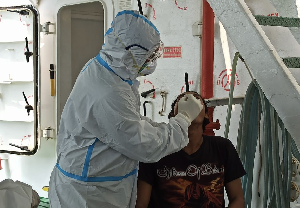
Christian Karagiannidis, Thomas Bein, Tobias Welte
European Respiratory Journal 2022 59: 2103262; DOI: 10.1183/13993003.03262-2021
Shedding new light on ECMO treatment in ARDS: moving from rescue therapy to a standardised treatment option with defined indications https://bit.ly/3zXAhyF
Coronavirus disease 2019 (COVID-19) led to an unprecedented number of patients on mechanical ventilation, many of them presenting with severe acute respiratory distress syndrome (ARDS). Depending on the resources of national healthcare systems, extracorporeal membrane oxygenation (ECMO) was frequently applied during the pandemic. While intensive care unit experience improved with this new disease, various forms of drug therapies were introduced in living guidelines, resulting in a dynamic development in outcome of COVID-19. Particularly noteworthy was the introduction of dexamethasone in the summer of 2020, and in 2021 the additional administration of tocilizumab in the early severe phase of the disease. A third important factor that had a significant impact on the outcome of severe respiratory failure was the start of vaccination programmes, primarily for risk groups, depending on national strategies, followed by the general public.
Depending on the phase of the pandemic, different studies showed a variable outcome for COVID-19 patients treated with ECMO. While in the first wave the in-hospital mortality remained below 40%, after the summer 2020 a significant mortality increase was seen in many centres. The latest data from the international ECMO registry (ELSO) showed a significant increase in hospital mortality of about 15% during the pandemic. In addition, in the German healthcare system, which is without significant limitations to access (no governmental restrictions, high reimbursement of invasive procedures), there was a higher in-hospital mortality of about 70% over the entire pandemic. The main questions that therefore arise are 1) why did mortality increase in the later phases of the pandemic, and 2) why did some healthcare systems, such as Germany's, have such a high mortality?
Riera et al. analysed some major risk factors in this issue of the European Respiratory Journal. Substantial factors were identified as being congruent worldwide, whereas others remain a matter of debate. Almost all studies show the most beneficial survival in patients under 50 years of age with a significant increase in mortality above 60 years of age. This is also evident in data from Germany, but age-stratified comparisons again show significant differences, such that not only age alone seems to play a major role. Furthermore, the work of Riera et al., as well as data from the Greater Paris area or from the last ELSO analysis, show that a high centre-associated experience, measured by the number of ECMO runs greater or less than 30 per year, has a significant influence on mortality. Experience and high-level routine thus seem to be one of the essential factors to reduce overall mortality. Somewhat incongruent also in the present work is the timing of ECMO initiation in relation to intubation; here it can be concluded from all available data that a very early initiation of the system, within the first 3 days, showed the best survival rates, while very late ECMO initiation showed a significantly higher mortality. However, timing alone cannot be used as a criterion for indication; other parameters, such as the stiffness of the lung or morphological changes on computed tomography, are needed. Furthermore, this raises the question if ECMO is still a rescue therapy or more or less the most invasive option to treat most severe hypoxaemic ARDS patients within its evidence-based indication.
In more detail, according to the values of medical ethics, physicians’ activities must be guided by two main principles: the indication and the patient's will. The indication to perform a diagnostic or therapeutic procedure (or to not!) is based on the careful assessment of a realistic rehabilitation of the patient in association with such a measure (e.g. ECMO), in order to allow the patient to continue life with a certain quality and to achieve a well-defined therapeutic goal, coordinated with the values and wishes of the individual patient. Since many guidelines claim the indication for ECMO as “rescue” or “ultima ratio” the above introduced definition of “indication” may be levered out (table 1). “Ultima ratio” (a phrase created in the Thirty Years’ War) could justify the use of ECMO under neglect of a careful and ethically valued indication. We assume that “rescue” and “ultima ratio” motivations may have contributed to a high mortality in patients treated with ECMO in some healthcare systems, such as Germany. Thus, with all current evidence taken into account, the indication for ECMO should be based on a careful assessment of several anamnestic, biographic, medical and prognostic parameters (table 1) in each individual patient to avoid futile treatments, as well as a high in-hospital mortality.
TABLE 1
A gradual assessment of indications for implementation of extracorporeal membrane oxygenation in critical acute respiratory distress syndrome (ARDS)
In summary, the main risk factors for poor survival are the age of the patient, previous experience of ECMO centres and pre-existing concomitant diseases. Hereby the indication for ECMO therapy moves more and more into focus, away from a rescue therapy to an extended standard therapy, which requires high expertise and an ethically based careful indication, and it has to be used with a sense of proportion. Even if its initiation remains an individual case-based decision, work such as that of Riera et al. should be taken as an opportunity to develop dedicated criteria.
Footnotes
-
Conflict of interest: C. Karagiannidis reports advisory fees from Xenios and lecture fees from Xenios and Getinge.
-
Conflict of interest: T. Bein has nothing to disclose.
-
Conflict of interest: T. Welte reports advisory fees from Xenios.
- Received December 28, 2021.
- Accepted January 3, 2022.
- Copyright ©The authors 2022














